Chapter: Modern Analytical Chemistry: Equilibrium Chemistry
Buffer Solutions
Buffer Solutions
Adding as little
as 0.1 mL of concentrated HCl to a liter of H2O shifts
the pH from 7.0 to 3.0. The
same addition of HCl to a liter
solution that is 0.1 M in both
a weak acid and
its conjugate weak
base, however, results
in only a negligible change
in pH. Such solutions are called buffers, and
their buffering action
is a consequence of the relationship between pH and the relative
concentrations of the conjugate weak acid/weak base pair.
A mixture of acetic acid and sodium
acetate is one example of an acid/base buffer. The equilibrium position of the buffer
is governed by the reaction
CH3COOH(aq)+ H2O(l) < == == > H3O+(aq)+ CH3COO–(aq)
and its acid dissociation constant

The relationship between
the pH of an acid–base
buffer and the relative amounts
of CH3COOH and CH3COO–
is derived by taking the negative log of both sides of equation 6.43 and solving
for the pH

Buffering occurs because
of the logarithmic relationship between
pH and the ratio of the
weak base and
weak acid concentrations. For example, if the equilibrium concentrations of CH3COOH and
CH3COO– are equal,
the pH of the buffer
is 4.76. If sufficient strong acid is added such that 10% of the acetate ion is converted to acetic acid, the concentration ratio
[CH3COO–]/[CH3COOH] changes to 0.818,
and the pH decreases to 4.67.
Systematic Solution to Buffer Problems
Equation 6.44 is written in terms of the concentrations of CH3COOH and CH3COO– at equilibrium. A more useful relationship relates the buffer’s pH to the initial concentrations of weak acid and weak base. A general buffer equation can be derived by considering the following reactions for a weak acid, HA, and the salt of its conjugate weak base, NaA.
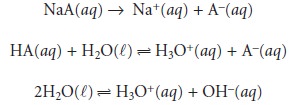
Since the concentrations of Na+, A–,
HA, H3O+, and
OH– are unknown, five equa- tions are needed to uniquely define
the solution’s composition. Two of these
equa- tions are given
by the equilibrium constant expressions

The remaining three
equations are given
by mass balance
equations on HA and
Na+
CHA + CNaA = [HA]+ [A–] 6.45
CNaA = [Na+] 6.46
and a charge
balance equation
[H3O+] + [Na+] = [OH–]+ [A–]
Substituting equation 6.46 into the charge balance
equation and solving
for [A–] gives
[A–]= CNaA –
[OH–]+ [H3O+]
6.47
which is substituted into equation 6.45 to give the
concentration of HA
[HA] = CHA + [OH–]– [H3O+] 6.48
Finally, substituting equations
6.47 and 6.48 into the Ka equation for HA and solv- ing
for pH gives the general
buffer equation

If the initial
concentrations of weak acid and weak base are greater
than [H3O+] and [OH–],
the general equation
simplifies to the Henderson–Hasselbalch equation.

As in Example 6.13, the Henderson–Hasselbalch equation provides
a simple way to
calculate the pH of a buffer and
to determine the
change in pH upon adding
a strong acid or strong base.
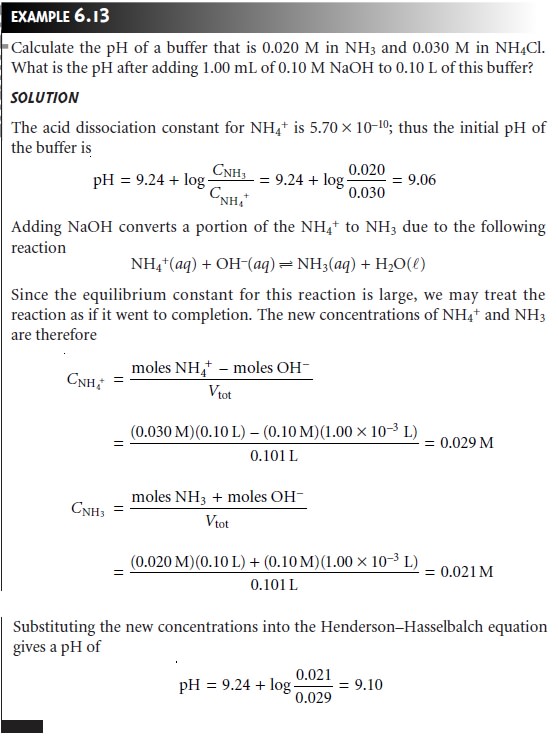
Multiprotic weak acids
can be used
to prepare buffers
at as many different pH’s as
there are acidic
protons. For example,
a diprotic weak acid can be used to prepare buffers at two pH’s and a triprotic weak acid can be used to prepare
three different buffers. The
Henderson–Hasselbalch equation applies
in each case.
Thus, buffers of malonic acid (pKa1 = 2.85 and
pKa2 = 5.70) can
be prepared for
which
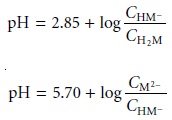
where H2M, HM–, and M2– are the different forms of malonic
acid.
The capacity of a buffer
to resist a change in pH is a function
of the absolute concentration of the weak acid and the weak base,
as well as their relative
propor- tions. The importance of the weak
acid’s concentration and
the weak base’s
con- centration is obvious. The more moles
of weak acid
and weak base
that a buffer has, the more strong
base or strong
acid it can neutralize without
significantly changing the buffer’s pH. The relative proportions of weak
acid and weak
base af- fect the
magnitude of the
change in pH when adding
a strong acid
or strong base. Buffers that are equimolar in weak acid and weak base require
a greater amount
of strong acid or strong base to effect
a change in pH of one unit. Consequently,
buffers are most effective to the addition of either acid
or base at pH values
near the pKa of the weak acid.
Buffer
solutions are often prepared
using standard “recipes” found in the chemical literature. In addition, computer programs
have been developed to aid in the
preparation of other
buffers. Perhaps the simplest
means of preparing a buffer, however, is to prepare
a solution containing an appropriate conjugate weak acid and weak base and measure its pH. The pH is easily adjusted
to the desired pH by adding small portions of either a strong acid
or a strong base.
Although this treatment
of buffers was based on acid–base chemistry, the idea of a buffer is general and can be extended to equilibria involving complexation or
redox reactions. For
example, the Nernst
equation for a solution containing Fe2+ and Fe3+ is similar in form to the Henderson–Hasselbalch equation.

Consequently, solutions of Fe2+ and Fe3+ are buffered to a potential near the
standard-state reduction potential for Fe3+.
Representing Buffer Solutions with Ladder Diagrams
Ladder diagrams provide a simple graphical description of a solution’s predominate species as a function of solution conditions. They also provide a convenient way to show the range of solution conditions over which a buffer is most effective.
For example, an acid–base
buffer can only exist when the relative
abundance of the weak
acid and its conjugate weak base are similar. For convenience, we will assume
that an acid–base buffer
exists when the
concentration ratio of weak base
to weak acid
is between 0.1 and
10. Applying the
Henderson–Hasselbalch equation
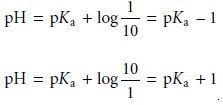
shows that acid–base buffer exists within
the range of pH = pKa ± 1. In the same manner, it is easy to show that a complexation buffer
for the metal–ligand complex MLn exists when
pL = log Kf ± 1, and that a redox
buffer exists for E = E° ± (0.05916/n). Ladder diagrams
showing buffer regions
for several equilibria are shown in Figure 6.13.
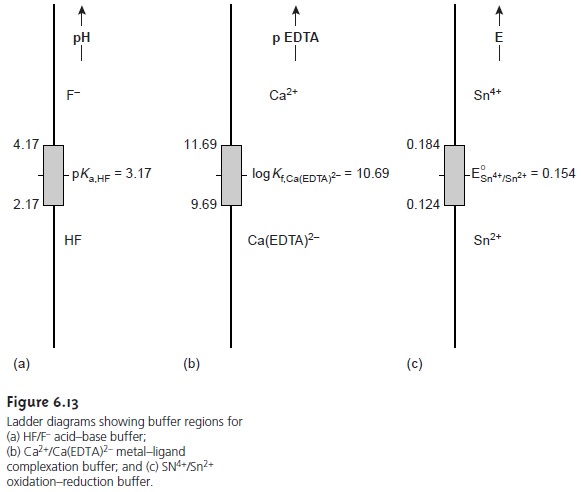
Related Topics